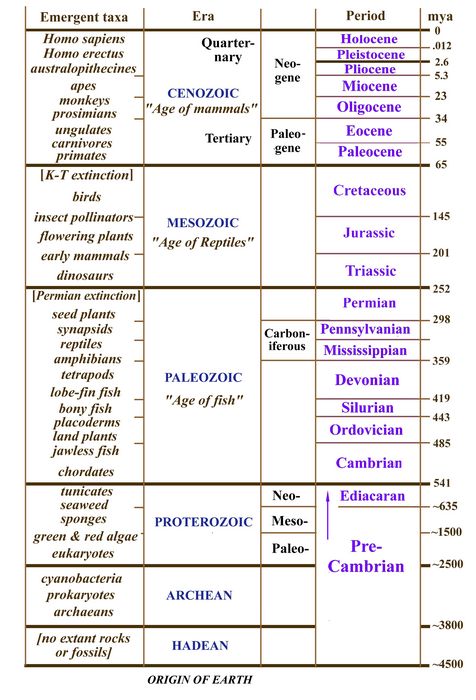Athena Review Image Archive ™
Geologic timescale

Geologic timescale (Athena Review).
This
chart shows the overall
geologic timescale, with emergent lifeforms in the left-hand
column. There are 18 geological periods, of which the
earliest, and by far the longest, is the Precambrian. Most of the
period names were devised in the 19th century, when the geological
strata recording the history and structure of the earth were first
correlated with fossil evidence that went with each period.
The
Precambrian (4.5 billion to 541 mya), lasting eight times as long
as the remaining seventeen geological periods put together.was not even
sketchily known until the mid-20th century, although its existence was
suspected by geologists in the early 19th century The Precambrian
lasted from the creation of the earth (estimated at about 4.5 billion
years ago) to the beginning of the Cambrian period (541-485 million
years ago), when complex marine animals began to flourish. For most of
these 4 billion years, known as the Archaean and Proterozoic eras, the
only living inhabitants of Earth were one-celled microbes resembling
bacteria. Complex life began in the last, neo-Proterozoic phase of the
Precambrian, called the Ediacaran.
The next seven geological periods, Cambrian through Permian, lasting from 541-252 million years ago (mya), comprise the Paleozoic, or "ancient life" era. This time span of 292 million years included the initial development of vertebrates from chordates through fishes, tetrapods, amphibians, reptiles, and the synapsids, who ultimately became the ancestors of mammals
The
next three periods (Triassic, Jurassic, and Cretaceous) are called
the Mesozoic or "middle life" era, lasting from 252-65 mya. This
era, also known as the age of reptiles, saw the rise and fall of the
dinosaur and other large reptiles, and ended with another major
extinction event at the the "K-T boundary". In this phrase, K is
the geologic map symbol for the Cretaceous period; while T stands for
"Tertiary", an older name for the next five periods, that make up the
Cenezoic era (the era of "recent life". Note that both the Paleozoic
and Mesozoic eras ended with big extinction events.
Meanwhile, the first small mammals appear in the in the Late Triassic and the Early Jurassic (about 220-180 mya), and develop as small animals until the Tertiary,
The five Tertiary periods, lasting from 65 to 2 mya, are the Paleocene, Eocene, Oligocene, Miocene, and Pliocene, all ending in -cene ("recent"). Worldwide, the Cenezoic era is called the "Age of Mammals", and is filled with all types of mammals expanding into new habitats from which large reptiles have now mostly disappeared.
By
the end of this era, the earliest ancestors of humans have developed
from earlier, ape-like primates. Then comes the period of intermittant
glaciers called the Pleistocene, from 2 million to 12,000 years ago,
which saw the whole span of the evolution of Homo (our genus). Following that comes our own brief period, called the Holocene ("fully recent") period.
References:
Copyright © 1996-2020 Rust Family Foundation (All Rights Reserved).